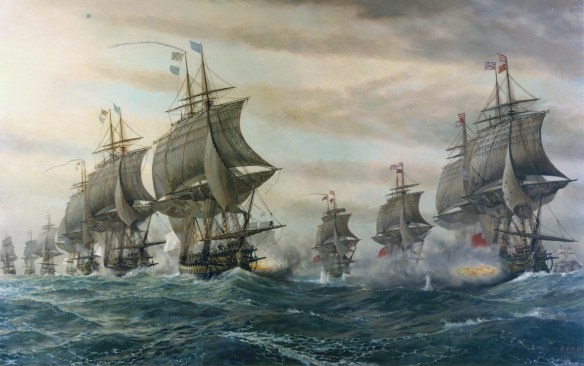British naval hegemony rested on a sophisticated and well-financed administrative structure, a large fleet drawing on the manpower resources of a substantial mercantile marine, although there was never enough sailors, and an ability to win engagements that reflected widely diffused qualities of seamanship and gunnery, a skilled and determined corps of captains, and able leadership. This was true not only of command at sea, as with Nelson’s innovative tactics and ability to inspire his captains, his “band of brothers”, but also of effective leadership of the navy as an institution. Thus Jervis, created Earl St. Vincent after his great victory, was an energetic First Lord of the Admiralty in 1801-4, although his hostility to naval contractors and his campaign for economy in the naval dockyards limited the rate of construction and repair, placing the navy in a difficult position in 1804. The reversal of this policy when St. Vincent resigned in 1804 ensured that by the end of 1808 the commissioned fleet totalled 113 of the line and 596 other ships. Admiral Charles Middleton, created Lord Barham in 1805, was an effective First Lord in 1805-6. He played an important role both in developing organizational efficiency and in providing able and effective leadership during the Trafalgar campaign. Able administrators such as Samuel Bentham and John Payne did much to develop the organizational infrastructure of the navy. Resources permitted and administrative systems supported the maintenance both of the largest battlefleet in the world and of a crucially large number of smaller warships
Better leadership helped in avoiding a repetition of the serious naval mutinies of 1797. That year, dissatisfaction over conditions, especially pay, provided a fertile basis for political discontent. The Spithead fleet refused to sail, there was trouble in St. Vincent’s fleet off Cadiz, and, more seriously, that at the Nore began to blockade the Thames until quelled by firm action. Later mutinies were on a smaller scale and more specific in their grievances. Thus in December 1801 the crew of some of the ships ordered to sail for the Caribbean mutinied. The mutiny was crushed and the ringleaders executed.
The infrastructure improved and became more farflung. New naval facilities were developed, both in Britain and abroad, for example at Malta, where Nelson established a ropeworks. Cape Town, Madras, Bermuda, Barbardos, Trincomalee and Bombay were developed as naval bases. Two new deep docks were created at Portsmouth in 1796-1800 and the basin was deepened in order to enable the docking of ships without unloading guns and equipment, although the facility was only occasionally used and then only for frigates requiring rapid attention. Signalling at sea, crucial to operational effectiveness, communications and co-ordinated action, improved from the 1780s, and a quick and flexible numerical system of signals was developed. The Admiralty Hydrographic Office was founded in 1795, with Alexander Dalrymple, since 1779 hydrographer to the East India Company, as first hydrographer of the Navy. Before then there had been no Royal Navy facilities especially for marine surveying or chart production.
Thanks to her naval resources, Britain was able to turn tactical triumphs to strategic advantage. As on land, mobility, firepower and determination were crucial in battle, although at sea these were always most readily applied in the offensive. Successive victories, particularly Trafalgar, conditioned British and foreign expectations, and the latter was crucial, because it affected French naval strategy, or rather the absence of it, for most of the rest of the war. Confidence is a vital military resource, and victory both brought it to Britain and denied it to France.
War of 1812
British naval power was also crucial in the war of 1812-15 with the United States. Naval blockades greatly harmed the American economy, amphibious forces were able to approach Baltimore and burn Washington, and it was possible to send reinforcements to Canada in order to resist successfully poorly led and unco-ordinated American attacks. In August 1814 a fleet under Vice- Admiral Sir Alexander Cochrane entered the Chesapeake. A squadron under James Gordon forced its way up the Potomac, silenced Fort Washington, captured Alexandria, Virginia and returned with a rich haul of merchantmen. Troops were convoyed up the Patuscent whence they marched on Washington. An unsuccessful attack was mounted on New Orleans in January 1815, but the British were able to send a force there, and when hostilities ceased an expedition was being planned against first Savannah and then Charleston, both of which were blockaded. The Treaty of Ghent had been signed in December 1814, but fighting continued until early 1815.
Although the Americans had the most powerful frigates of the age, they had no ships of the line and their total navy at the outset comprised only 17 ships. The Americans were to capture three British frigates in 1812, but the other British naval losses were all of smaller vessels. Nevertheless, the British suffered initially from over confidence, inaccurate gunnery and ships that were simply less powerful and less well prepared than those of their opponents. However, British gunnery improved during the war, as, more generally, did their naval effectiveness. They developed a fleet on the Great Lakes. In 1814 the British were able to construct a 112-gun ship at the naval base at Kingston on Lake Ontario which had been founded in 1784.
